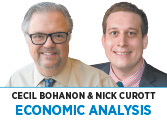Subscriber Benefit
As a subscriber you can listen to articles at work, in the car, or while you work out. Subscribe Now The surprisingly strong January jobs report smashed all forecasts. The economy gained 467,000 jobs last month, signaling the omicron variant has not slowed the economy as feared. President Joe Biden publicly seized upon the stunning report as proof of the success of his administration’s policies. So, is the president correct?
The surprisingly strong January jobs report smashed all forecasts. The economy gained 467,000 jobs last month, signaling the omicron variant has not slowed the economy as feared. President Joe Biden publicly seized upon the stunning report as proof of the success of his administration’s policies. So, is the president correct?
The goal of stimulus policy in a recession should be to keep total income in the economy growing on an even track. When private spending drops suddenly, as during the early days of the pandemic, it is appropriate for the central bank and the federal government to attempt to make up the difference. Too little stimulus and the dollar value of household income falls, which results in bankruptcies, loan defaults and worker layoffs. Too much stimulus results in inflation.
The best way to assess how our policymakers have performed is by gauging how well they have kept the dollar value of income in the economy—what economists call nominal gross domestic product (NGDP)—growing on its expected path. The “NGDP Gap,” measured by the Mercatus Center at George Mason University, does this by taking NGDP each quarter and comparing it to the level of NGDP that workers and firms were expecting when entering wage and loan contracts. By this measure, NGDP was 11.54% below expectation in the second quarter of 2020, indicating need for massive stimulus. Policymakers responded swiftly, and the NGDP gap closed by the third quarter of 2021. This was much faster than after the recession of 2009, when the gap took nearly a decade to close.
General monetary and fiscal policy stimulus—including low-interest-rate policies, federal stimulus checks and unemployment supplements—has helped address cyclical unemployment by providing financial support to ease the economically induced pain of lockdowns. The unemployment rate, which spiked up to 14.5% in April 2020, has quickly come down to 4% and is near pre-recession levels. The jobs report also found wage growth surged to 5.7% over the last year, indicating labor markets are tight. Employment data suggests it’s time to ease up on the monetary- and fiscal-policy gas pedal.
The danger now is that policymakers might overshoot the mark. NDGP is currently 3.02% above expectation, indicating stimulus is now beyond the appropriate amount. Unless monetary and fiscal stimulus is reined in quickly, it could accelerate the current bout of high inflation.
That would spell bad news for Biden. Historically, voters oust the incumbent party when inflation is high before an election.•
__________
Bohanon and Curott are professors of economics at Ball State University. Send comments to [email protected].
Please enable JavaScript to view this content.

Yes, we need to react, but carefully. A couple of reasons for caution. Inflation is high in many advanced countries, including some that did not provide the stimulus that we did. Supply disruptions are affecting everyone. But our inflation rate is still a little higher and some of this can be attributed to our stimulus. At the same time, we also need to acknowledge that our employment-to-population ratio is still below pre-pandemic levels (and very much below what it was before the great recession). Our industries are much more concentrated and unions much weaker than the last time we significant inflation. Embedding inflation in wage growth is not the same risk as before. If we use interest rates to react to inflation (rather than supply side interventions) the burden will be felt by construction workers and other other interest rate-sensitive occupations. So, caution. We need to react but carefully.